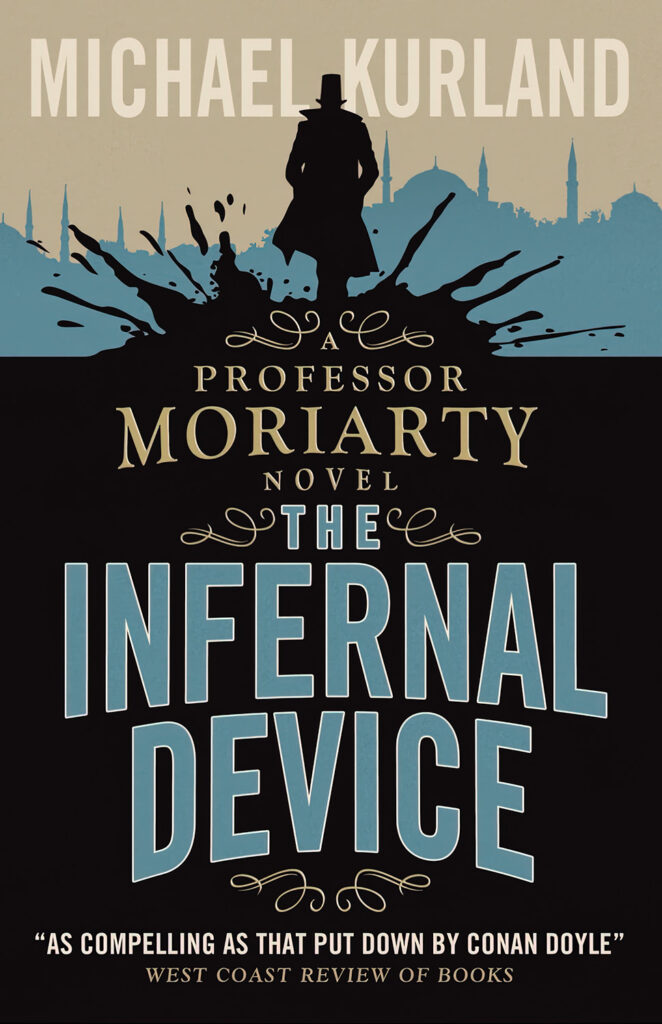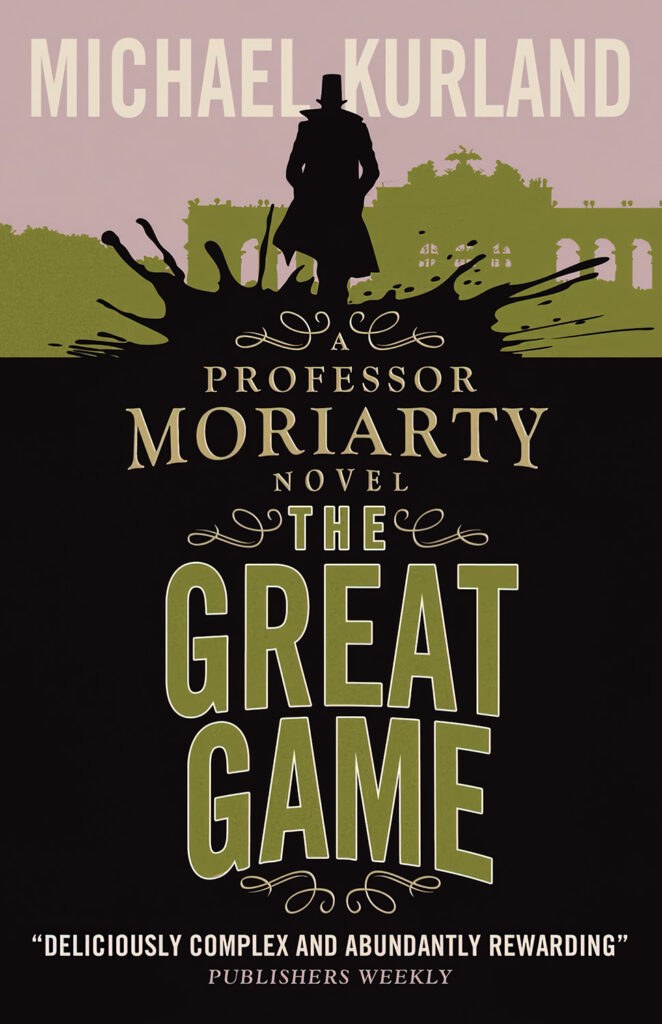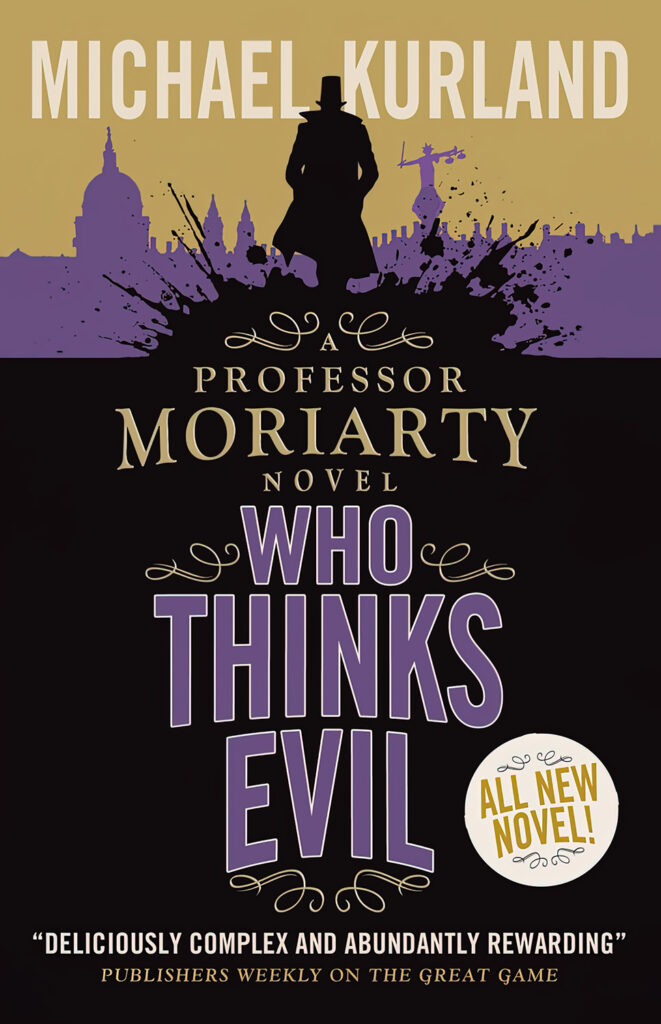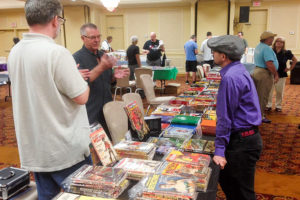 I am aware of at least three authors who have written series with the Professor, and who knows how many stand-along novels or short stories. Michael Kurland probably has the longest series of novels and short stories with him.
I am aware of at least three authors who have written series with the Professor, and who knows how many stand-along novels or short stories. Michael Kurland probably has the longest series of novels and short stories with him.
Fortunately, Titan Books began reprinting the novels a few years back in a new uniform edition, along with a new, fifth novel, over 30 years after the first one! For the short stories, get the volume Victorian Villainy from Wildside Press.
Kurland’s Professor Moriarity series includes:
- The Infernal Device (1978)
- Death by Gaslight (1982)
- “The Paradol Paradox” (short story, 2001)
- The Great Game (2001)
- “Years Ago and in a Different Place” (short story, 2003)
- “Reichenbach” (short story, 2004)
- The Empress of India (2006)
- “The Picture of Oscar Wilde” (short story, 2011)
- Who Thinks Evil (2014)
So how does Kurland handle Moriarty? I had read others description of the series, but decided to read them and put forth my take.
In this series, Moriarty is portrayed not quite as we’ve come to expect. Or, as stated on the author’s website: “Professor Moriarty is not as much of a villain as you’ve been led to believe.”
He is not the “Napoleon of Crime” that we are told in the Holmes series. He does not head a large network of criminals, but has but a handful of people who work for him. Instead, Holmes, due to long standing issues with the Professor, has fixated on the idea that he is at the center of all crime in England.
What you see if you read the first novel is that Moriarty is a “consultant” for others. Those others could be governments or organizations. And they may be of a criminal nature, but not to the level that Holmes believes.
Moriarty usually works out a solution to their problem, in some cases taking an active part. And he does this to fund his own scientific research, not so much to enrich himself. Over time, we will learn what has lead to the falling out between Holmes and Moriarty. In one story, Moriarty calls himself the first “consulting criminal,” in counterpoint to Holmes.
Things kick off, for us, in the first novel, The Infernal Device. Our entry into the world of Moriarty is through American journalist Benjamin Barrett, who is in Constantinople to report on sea trials of a new submarine. He meets a British naval officer, and they team up. They even have an encounter with Moriarty, saving him from a group attacking him.
The naval officer lets Benjamin know he is actually a military spy and needs help, but he is killed and Benjamin is framed, imprisoned, and condemned to death. Moriarty appears and offers to get him out for a price: work for him for two years. Benjamin agrees, and Moriarty does.
 Benjamin becomes his latest agent, now working as Benjamin Barnett, as he is believed dead in Turkey. Moriarty is currently working for the Russians to find and stop a dangerous Russian agent operating in London. It was this agent who framed Benjamin and has tried to kill Moriarty a couple of times already. Making it difficult: No one knows what this agent looks like, or what his plan is, even the Russians.
Benjamin becomes his latest agent, now working as Benjamin Barnett, as he is believed dead in Turkey. Moriarty is currently working for the Russians to find and stop a dangerous Russian agent operating in London. It was this agent who framed Benjamin and has tried to kill Moriarty a couple of times already. Making it difficult: No one knows what this agent looks like, or what his plan is, even the Russians.
So Benjamin sets up an American news service to make contacts with the British papers, allowing him to gather information that may help Moriarty. He also hires a secretary, Cecily Perrine, who wants to be a journalist, and who will become more important to Benjamin. Benjamin is also introduced to Moriarty’s house staff: Mr. Maws, a former prizefighter and now butler; and Mrs. H, the housekeeper. We are never told was the “H” stands for.
We also meet Mummer Tolliver, who introduces Benjamin to an ancient society of beggars who will serve as Moriarty’s eyes and ears. His “Baker Street Irregulars.” And, yes, Sherlock Holmes appears. Oh, and if you wonder where Col. Sebastian Moran is, he’ll pop up in the second novel as a minor character and in another novel in a larger role. But he is not Moriarty’s right-hand man in any way.
Moriarty works to find the Russian agent. Holmes is also pulled in without knowing it due to the kidnapping of a lord’s daughter. Can Moriarty stop the agent, with or without Holmes help (or interference)? Find out!
Now Benjamin is no Watson. He’s not a friend to the professor, nor does he write up the professor’s adventures. He wants no publicity. But it’s through him that we find out what’s going on.
The next novel, Death by Gaslight, is set in 1887, about two years after the last one. In fact, Barnett is coming up on his two years of service to the professor and is planning on asking Cecily to marry him.
Meanwhile, there is a serial killer slitting the throats of noblemen. It’s not clear at first why or what their connect is. Sherlock Holmes is asked to look into it, and thanks to his obsession with Moriarty, thinks he is involved (he’s not). Moriarty is working on his scientific research, as well as helping a mysterious client known only as Singh.
Things come to a head in both matters as Cecily has been investigating the crime, putting herself in grave danger. And the assistance being given to Singh will be seen by some as a major criminal act. Moriarty is then approached by an “gentlemen’s club of criminals,” of which Col. Moran is a leader, to also put a stop to the serial killer, as the actions of the police are impacting the criminal underworld. Moriarty, with Benjamin’s help, is able to figure out who is behind the killings and why, and is on the move. Holmes will also come into this as well.
The Great Game is set four years later in 1891. The title kind of confused me, as when I think of the “Great Game,” I think of Great Britain and Russia fighting each other through various agents in the area of India, whereas this is set in Europe.
We have two storylines that will come together, pulling in Holmes and Moriarty. In one, the younger son of a Duke is working as a spy in Vienna, getting involved with various groups including anarchists. But he is framed for the murder of an Austrian duke and his lover. Barnett and his wife are vacationing in Europe, and notice that someone seems to be following them. In Italy, they meet another couple and are shocked when an anarchist tries to kill the couple with a bomb. They learn the couple is a prince and princess of a small country within Austro-Hungary. There is someone behind all these actions, trying to bring about unrest in Europe. Barnett and his wife are pulled into it, as those behind it think Moriarty is actually the head of British Intelligence, and they are imprisoned. It will take Moriarty to figure out what is going on and get them all out — maybe with some help from Holmes again.
I was a little surprised to see The Empress of India is set in 1890. This time the Barnetts do not appear, and Col. Moran takes on a bigger role.
As with other novels, there are several story threads here that come together toward the end. First off, Holmes is engaged by the Bank of England to help them secure a large shipment of gold bullion coming from India on The Empress of India. But in investigating, he disappears under mysterious circumstances! Is he dead or captured?
 At the same time. Col. Moran comes to Moriarty for help with a matter he has: the retrieval of a statue on behalf of a maharajah in India, who will pay both of them for returning it as long as no one is hurt. Its location is known; it’s in the possession of a British regiment in India, who see it as a good-luck item, and so would be reluctant to part with it. And they will be traveling on The Empress as additional security.
At the same time. Col. Moran comes to Moriarty for help with a matter he has: the retrieval of a statue on behalf of a maharajah in India, who will pay both of them for returning it as long as no one is hurt. Its location is known; it’s in the possession of a British regiment in India, who see it as a good-luck item, and so would be reluctant to part with it. And they will be traveling on The Empress as additional security.
At the same time, we see a mysterious Dr. Pin Dok Low, who seems to be a Chinese mastermind who is watching both homes of Holmes and Moriarty. He also seems interested in the gold bullion and has recruited others to help.
In India, we meet several folks connected to the regiment that will be accompanying the gold, and a British spy who comes to report to the viceroy is killed, apparently by Thuggees! Is there another force after the gold? It seems we will have Moriarty and Moran on The Empress, though not after the gold, but others will think so. But it’s Dr. Pin Dok Low and others who are. How will it all shake out? Will Moriarty and Moran succeed in their mission? Will the gold be stolen? Who will try to steal the gold? And will Holmes show up?
The most recently novel is Who Thinks Evil. It’s set in 1892 and finds Moriarty in prison awaiting trial for a crime he did not commit. A group of criminals tried to rob a nobleman’s home, either getting killed or run off. But someone claimed it was all planned by Moriarty. But a young nobleman goes missing. And the young lady he was with was murdered in a most horrifying means. Then he apparently shows up at another house of ill repute, where a young man is horribly killed as well. Sherlock Holmes is unavailable. So Moriarty is sprung and given the tasks to try to find this young man, but with the greatest secrecy. Why all of this? Well, he’s the grandson of Queen Victoria. Moriarty is again joined by Benjamin Barnett in this one. Is the young nobleman guilty of these murders or is it someone else, and why has he disappeared? And is there any connection to someone claiming Moriarty was behind the robbery? And will Holmes appear?
Now, as I noted, there are five short stories. I’ve only read two. One is “Reichenbach,” and it’s what you might think. It’s what really happened at Reichenbach Falls between Holmes and Moriarty. But we find that it is all a dodge to allow the two to work against a foreign force.
The other is “Years Ago and In a Different Place,” which tells of the origin of Holmes animosity against Moriarty, which happened when Holmes met him while attending college — and of Holmes’ first love. Sort of. I’m not quite what I expected.
I hope to read the others. This is a great series. As noted, all are available from Titan Books and Wildside Press, there is little reason not to be able to obtain and read this series. I have no idea if Kurland will write another. Hopefully if he does, it will be of the same quality as these.




Your comments